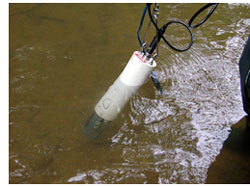
Water has often been called the universal solvent --- almost anything dissolves in water. Even very clear water has different things dissolved in it. This is often a selling point for different bottled waters you can buy in the supermarket. If the water is cloudy (turbid) that is because whatever is making the water turbid is not dissolved in the water.
Many things can be dissolved in the water, and a relative few things can make big differences in what lives in a stream. The fertilizers used on land to make plants grow make water plants (mainly algae) grow even more. The various poisons we use to kill weeds and bugs on land can often do an even better job killing plants and animals in a stream. Pollution in the air we breathe can be dissolved in the water along with the oxygen that dissolves from the air. The ground that the stream runs through can contribute to the dissolved contents of the water.
Whether the things dissolved in the water cause good or harm depends a lot on how much of it there is dissolved in a quantity of the water, and on what is needed by the stream communities.Take common table salt for example: 35 parts of common salt in one thousand parts of water is great for sharks and whales, but it will kill every goldfish or minnow that would chance to swim in this water.
The expression of the dissolved content of the water may be easily stated as parts per thousand (ppt), parts per billion (ppb), percent (parts per hundred), or some other form expressing the concentration. What that means to the organisms living in the water depends on many other factors.